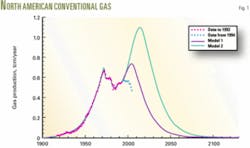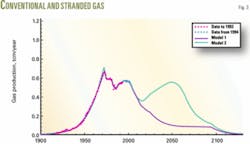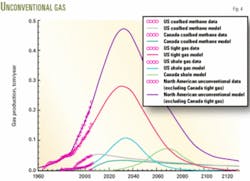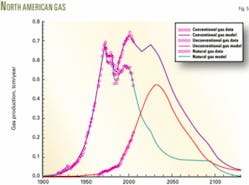Steve H. Mohr, Geoffrey M. Evans, University of Newcastle, Newcastle, Australia
Models using a history match of past production and a bell-curve approach provide an insight to the various estimates for ultimate recovery of conventional and unconventional gas resources in North America.
The assessment will model natural gas production in North America to 2130, except for gas hydrates.
Conventional gas
Published estimates of ultimate recovery resources (URR) for conventional gas in North America vary markedly. In particular, Laherrere estimates 42.5 trillion cu m (tcm) for US and Canada,1 whereas Rempel estimates 69 tcm for US, Canada, Mexico, and Greenland.2
Greenland and Mexico combined have about 6 tcm of estimated URR.3 The URR estimates, therefore, for US and Canada differ by about 20 tcm.
To determine a likely URR estimate for North America, the assessment used a model with various assumptions.4
Model 1 used Laherrere’s URR estimate of 42.5 tcm for US plus Canada, and Model 2 used Rempel’s URR estimate of 63 tcm for US plus Canada.
Conventional gas production data exclude coalbed methane, shale gas, and US tight gas and were obtained from a variety of sources.5-14 Data from these sources unfortunately include Canada’s tight-gas production.
Canada produces about 10-12 billion cu m/year from tight-gas sands.15 16 Accordingly, both models add a Canadian tight-gas URR estimate of 2 tcm to the conventional URR estimates.
Fig. 1 illustrates the predictions. Both models used only historic US and Canadian conventional natural gas production from 1918 to 1993.
The figure shows that from 1994 to 2005 the modeled production deviates from historic data that plateau from 1995 to 2001. Both models increase production in this period.
Model 1 peaks in 2003 and rapidly declines, which is similar to the production data that decrease rapidly from 2001 onwards. Model 2 peaks in 2011 before rapidly declining. Both models appear not to predict future production well.
To provide a better prediction, the assessment modified both models to account for stranded gas. From literature, northern North America has about 6.7 tcm of stranded gas.17 18 Production of this gas cannot begin until the industry builds pipelines, and it is uncertain when those pipelines will be completed. An estimate places the date at about 2015 or slightly earlier.18
Estimates also indicate that the pipelines will have a maximum gas flow capacity of about 7.8 bcfd.18
Production from stranded North American gas with a 7-tcm URR can be simply modeled by assuming production increases linearly from completion of the pipeline to a maximum production pipeline capacity, followed by an exponential decline (Fig. 2).
The stranded gas was incorporated into modified versions of Models 1 and 2, which used production data to 2005 and consequently reduced the conventional unstranded gas URR estimates by 7 tcm, to obtain 37.5 and 58 tcm, respectively (Fig. 3).
The two models produce different estimates of future conventional gas production. Model 1 predicts gas production will decrease steadily. Conversely, Model 2 shows a continued decrease until 2015, followed by a significant increase in production to a peak in 2049.
Of the two predictions, Model 2 is more unlikely, given the increasing reliance on unconventional gas, which now supplies more than 30% of US and Canada’s natural gas. Why develop expensive unconventional gas if large amounts of conventional reserves exist?
In looking at the US URR estimate, which is calculated as the sum of produced, reserves, and resources, the production and reserves estimates of 28.7 tcm and 5.6 tcm, respectively, appear to be values of combined unconventional and conventional gas, contradicting its claim of being a conventional gas assessment.3
Unconventional gas
The assessment also can include unconventional gas in the model. URR estimates of unconventional gas in the US are:
- Tight gas: 200-627 tcf.11 19-22
- Coalbed methane: 50-180 tcf.9 23 24
- Shale gas: 50-150 tcf.8 11 24
The model used the highest estimates of 600 tcf (17 tcm) tight gas, 180 tcf (5 tcm) coalbed methane, and 150 tcf (4.2 tcm) shale gas.
As stated earlier, Canada also produces tight gas, but the production data are unavailable. The model, therefore, adds 2 tcm (70 tcf) to the URR estimates to accommodate Canadian tight-gas production.
Estimates of tight-gas resources in Canada vary from 300 tcf to 700 tcf.15 25-27 The US has about 6,000 tcf of tight gas in place, and as stated the URR is about 600 tcf, which equates to about a 10% recovery.28 The model assumes Canada’s tight-gas URR is 70 tcf (2 tcm), which is 10% of the highest resource estimate.
The 70-tcf estimate is optimistic given current recoverable estimates are 10-15 tcf.15 Estimates are that Canada’s coalbeds hold 167 tcf of recoverable gas,18 and its shale gas resources are at least 860 tcf,29 although “tens of thousands of tcf” may be in place.30
The model assumes a recovery of 100 tcf of Canadian shale gas.
The shale and tight-gas models use bell curves for estimating production. Canada still does not have shale-gas production; therefore, the model assumes that the bell curve slope for Canada is the same as for the US shale model. Production is assumed to start in 2010 at 1% of maximum.
The coalbed methane model works by fitting a parabola, Equation 1 (see equation box), to the production information, which are data for the US7 and prediction for Canada.16 18
At the year xd the function shifts to an exponential decay. The model solves the variable xd to ensure that the area under the graph agrees with the URR estimate of the coalbed model (Equation 2).
Fig. 4 shows the unconventional gas models.
Adding these models to the Model 1 for North American conventional gas provides an outlook of future natural gas production (Fig. 5).
Because of unconventional and stranded gas, production remains almost steady until 2025 before declining.
North America is no longer self-sufficient in natural gas and requires more LNG imports to ensure meeting future gas demands.
Finally, a word of caution: URR estimates are only estimates. In a 30-year timeframe, they may be low or high. More production data will provide better future estimates. In particular, the model used for Canada’s shale gas is highly speculative. Also a lack of a tight-gas definition in Canada and limited unconventional data also create considerable uncertainty.
Acknowledgments
The authors thank Jean Laherrere, Hilmar Rempel, Garth Sloan, Ted Callister, and the US Energy Information Administration (EIA) for their correspondence.
References
1. Laherrere J., “Natural gas future supply,” 2004, http://www.oilcrisis.com/laherrere/IIASA2004.pdf, retrieved June 6, 2007..
2. Rempel H., “Energy study 2005: Natural gas” http://www.bgr.bund.de/cln_011/nn_335996/EN/Themen/Energie/Erdgas/energy_study_gas_2005.html, retrieved May 11, 2007.
3. Gerling, P. et al., “Reserves, resources and availability of energy resources 2005,” http://www.bgr.bund.de/nn_335074/EN/Themen/Energie/Produkte/annual_report_2005,templateId=raw,property=publicationFile.pdf/annual_report_2005.pdf, retrieved June 14, 2007.
4. Mohr, S.H., and Evans, G.M., “Mathematical model forecasts year conventional oil will peak” OGJ, May 7, 2007, p. 45.
5. EIA, http://www.eia.doe.gov/emeu/international/contents.html, retrieved May, 23 2007,
6. BP statistical review of world energy June 2006, http://www.bp.com/statisticalreview, retrieved May 23, 2007.
7. EIA, http://tonto.eia.doe.gov/dnav/ng/hist/rngr52nus_1a.htm, retrieved May 4, 2007.
8. Benneche, J., “Natural Gas projections from EIA and six others” EIA Energy Outlook, Modeling and Data Conference, Washington DC, Mar. 28, 2007.
9. Curtis, J.B., “Fractured shale-gas systems,” AAPG Bulletin, Vol. 86, No. 11, 2002, pp. 1921-38.
10. Kuuskraa, V.A., et al., “Tight sands gain as US gas source,” OGJ, Jan. 22, 1996, p. 102.
11. Kuuskraa, V.A., and Banks, G.C., “Gas from tight sands, shales a growing share of US supply,” OGJ, Dec. 8, 2003, p. 34.
12. Bureau of Economic Geology, University of Texas at Austin, Natural Gas Presentation, http://www.beg.utexas.edu/techrvw/presentations/talks/tinker/tinker01/page05.htm, retrieved Apr. 30, 2007.
13. CAPP Statistical handbook, November 2006, http://www.capp.ca/default.asp?V_DOC_ID=1071, retrieved May 23, 2007.
14. 20th Century Petroleum Statistics, 61st edition, DeGolyer and MacNaughton, 2005.
15. Park, G., “Technology key to Canadian tight gas,” Petroleum news, Vol. 11, No. 4, 2006, http://www.petroleumnews.com/pntruncate/116310268.shtml, retrieved May 29, 2007.
16. Gatens, M., “Unconventional gas in Canada: An important new resource,” CERI 2005 Energy and Environment Workshop, Apr. 4, 2005, http://www.csug.ca/pres/CSUG%20060504%20CERI_Energy_Environment.pdf, retrieved from May 29, 2007.
17. Sherwood, K.W., “Prospects for development of Alaska Natural Gas: A review,” Methane Hydrates Interagency R&D Conference, Washington DC, Mar. 20-22, 2002.
18. Stringham, G., Canadian Natural Gas Outlook, CAPP Report, October 2006, http://www.capp.ca/raw.asp?x=1&dt=PDF&dn=110467, retrieved May 21, 2007.
19. Pike, B., “Energy Supply: The role of natural gas,” Hart Energy Conference, Dallas, http://hartenergyconferences.com/hydratemethane06/BPike.pdf, retrieved May 7, 2007.
20. Moritis, G., “Unlocking gas from tight sands,” OGJ, Feb. 27, 2006, p. 17.
21. Haines, L., “Tight Gas,” Supplement to Oil and Gas Investor, March 2006, http://www.oilandgasinvestor.com/pdf/TightGas.pdf, retrieved May 7, 2007
22. Doherty, M.G., “Unconventional natural gas resource.” GPA Annual Conference, Vol. 61, 1982, pp. 22-28.
23. Natural Gas Org, “Resources,” http://www.naturalgas.org/overview/resources.asp, retrieved Apr. 30, 2007.
24. Sandrea, R., “Global Natural gas reserves-A heuristic viewpoint part 2,” Middle East Economic Survey, Vol. 49, No. 12, 2006, http://www.mees.com/postedarticles/oped/v49n12-5OD01.htm, retrieved May 1, 2007.
25. “Canada’s gas supply shifting to new sources,” OGJ, June 12, 2006, p. 13.
26. Chow, K., “Unconventional gas in Canada: Past, Present, Future” CSUG, May 17, 2005, http://www.csug.ca/pres/CSUG%20050517%20Chamber%20of%20Commerce.pdf, retrieved May 29, 2007.
27. CAPP, http://www.capp.ca/default.asp?V_DOC_ID=733, retrieved May 29, 2007.
28. NETL website “Natural gas production from tight gas accumulations,” http://www.netl.doe.gov/technologies/oil-gas/EP_Technologies/ExplorationTechnologies/TightGas/Tight_Gas.html, retrieved May 29, 2007.
29. Oil and Gas in Alberta, http://www.oilandgasinalberta.ca/oilandgas.asp?href=/generator.asp?xml=/silos/ong/ShaleGas/shaleGasOverview04XML.asp&template=1,2,4, retrieved May 29, 2007.
30. Faraj, B., “Shale gas potential of selected shale formations in the Western Canada Sedimentary Basin,” Fifth Annual Unconventional Gas and Coalbed Methane Conference, Oct. 22-24, 2003, http://www.ptac.org/cbm/cbmf0301a.html, retrieved May 29, 2007.
The authors
Steve Mohr (steve.mohr@ studentmail.newcastle.edu.au) is a PhD candidate at the University of Newcastle, Australia, and is currently modeling supply and demand of transport fuels to 2100 as part of his PhD requirements. Mohr has a combined chemical engineering and mathematics degree from the University of Newcastle, Australia.
Geoffrey Evans ([email protected]) is professor of chemical engineering at the University of Newcastle, Australia, and has a research background in multiphase systems as well as in life cycle analysis and sustainable resource processing. Evans has a PhD from the University of Newcastle, Australia.








